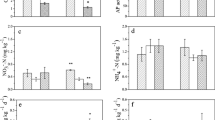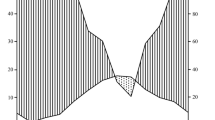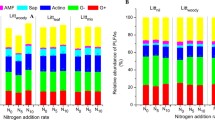Abstract
The effects of the understory shrub Ledum palustre on soil N cycling were studied in a hardwood forest of Interior Alaska. This species releases high concentrations of phenolic compounds from green leaves and decomposing litter by rainfall. Organic and mineral soils sampled underneath L. palustre and at nearby non-Ledum sites were amended with L. palustre litter leachates and incubated at controlled conditions. We aimed to know (i) whether L. palustre presence and litter leachate addition changed net N cycling rates in organic and mineral soils, and (ii) what N cycling processes, including gross N mineralization, N immobilization and gross N nitrification, were affected in association with L. palustre. Our results indicate that N transformation rates in the surface organic horizon were not affected by L. palustre presence or leachate addition. However, mineral soils underneath L. palustre as well as soils amended with leachates had significantly higher C/N ratios and microbial respiration rates, and lower net N mineralization and N-to-C mineralization compared to no Ledum and no leachates soils. No nitrification was detected. Plant presence and leachate addition also tended to increase both gross N mineralization and immobilization. These results suggest that soluble C compounds present in L. palustre increased N immobilization in mineral soils when soil biota used them as a C source. Increases in gross N mineralization may have been caused by an enhanced microbial biomass due to C addition. Since both plant presence and leachate addition decreased soil C/N ratio and had similar effects on N transformation rates, our results suggest that litter leachates could be partially responsible for plant presence effects. The lower N availability under L. palustre canopy could exert negative interactions on the establishment and growth of other plant species.
Similar content being viewed by others
References
Aguilera L E, Gutiérrez J R and Meserve P L 1999 Variation in soil micro-organisms and nutrients underneath and outside the canopy of Adesmia bedwellii (Papilionaceae) shrubs in arid coastal Chile following drought and above average of rainfall. J. Arid Environ. 42, 61–70.
Bonan G B 1990 Carbon and nitrogen cycling in North American boreal forests. 1. Litter quality and soil thermal effects in interior Alaska. Biogeochemistry 10, 1–28.
Blum U 1998 Effects of microbial utilization of phenolic acids and their phenolic acid breakdown products on allelopathic interactions. J. Chem. Ecol. 24, 685–708.
Blum U and Shafer S R 1988 Microbial populations and phenolic acids in soil. Soil Biol. Biochem. 20, 793–800.
Boufalis A and Pellissier F 1994 Allelopathic effects of phenolic mixtures on respiration of two spruce mycorrhizal fungi. J. Chem. Ecol. 20, 2283–2289.
Bradley R L, Fyles J W and Titus B 1997 Interactions between Kalmia humus quality and chronic low C inputs in controlling microbial and soil nutrient dynamics. Soil Biol. Biochem. 29, 1275–1283.
Bryant J P, Chapin F S I and Klein D R 1983 Carbon/nutrient balance of boreal plants in relation to vertebrate herbivory. Oikos 40, 357–368.
Chen J and Stark J M 2000 Plant species effects and carbon and nitrogen cycling in a sagebrush-crested wheatgrass soil. Soil Biol. Biochem. 32, 47–57.
Clein J S and Schimel J P 1995 Nitrogen turnover and availability during succession from Alder ti Poplar in Alaskan taiga. Soil Biol. Biochem. 27, 743–752.
Fox R H, Myers R J K and Vallis I 1990 The nitrogen mineralization rate of legume residues in soil as influenced by their polyphenol, lignin, and nitrogen contents. Plant Soil 129, 251–259.
Gallardo A and Merino J 1992 Nitrogen immobilization in leaf litter at two Mediterranean ecosystems of SW Spain. Biogeochemistry 15, 213–228.
Gallet C and Pellissier F 1997 Phenolic compounds in natural solutions of a coniferous forest. J. Chem. Ecol. 23, 2401–2412.
Goering H K and Van Soest P J 1970 Forage fiber analysis: apparatus, reagents, procedures and some applications. Agricultural Research Service, USDA, Washington, DC, USA. 20 pp.
Hamilton J G, Zangerl A R, DeLucia E H and Berenbaum M R 2001 The carbon-nutrient balance hypothesis: its rise and fall. Ecol. Lett. 4, 86–95.
Harborne J B 1997 Role of phenolic secondary metabolites in plants and their degradation in nature. In Plant Litter Quality and Decomposition. Ed. G Cadisch and K E Giller. pp. 67–74. Cab International, Wallingford, UK.
Hart S C, Stark J M, Davidson E A and Firestone M K 1994 Nitrogen mineralization, immobilization and nitrification. In Methods of Soil Analysis. Ed. J M Bigham. pp. 985–1018. Soil Science Society of America.
Hättenschwiler S and Vitousek P M 2000 The role of polyphenols in terrestrial ecosystem nutrient cycling. Trends Ecol. Evol. 15, 238–243.
Hobbie S E 1992 Effects of plant species on nutrient cycling. Trends Ecol. Evol. 336–339.
Holmes R M, McClelland J W, Sigman D M, Fry B and Peterson B J 1998 Measuring 15N-NH4 + in marine, estuarine and fresh waters: An adaptation of the ammonia difussion method for samples with low ammonium concentrations. Mar. Chem. 60, 235–243.
Hook P B, Burke I C and Lauenroth W K 1991 Heterogenity of soil and plant N and C associated with individual plants and openings in North American shortgrass steppe. Plant Soil 138, 247–256.
Horner J D, Gosz J R and Cates R G 1988 The role of carbonbased plant secondary metabolites in decomposition in terrestrial ecosystems. Am. Nat. 132, 869–883.
Inderjit and Mallik A U 1996a The nature of interference potential of Kalmia angustifolia. Can. J. For. Res. 26, 1899–1904.
Inderjit and Mallik A U 1996b Growth and physiological responses of black spruce (Picea mariana) to sites dominated by Ledum groenlandicum. J. Chem. Ecol. 22, 575–585.
Inderjit and Mallik A U 1997 Effects of Ledum groenlandicum amendments on soil characteristics and black spruce seedling growth. Plant Ecol. 133, 29–36.
Jackson R B and Caldwell M M 1993 Geostatical patterns of soil heterogenity around individual perennial plants. J. Ecol. 81, 683–692.
Jonasson S, Havström M, Jensen M and Callaghan T V 1993 In situ mineralization of nitrogen and phosphorus of artic soils after perturbations simulating climate change. Oecologia 95, 179–186.
Kirkham M B and Bartholomew WV 1954 Equations for following nutrient transformations in soil, utilizing tracer data. Soil Sci. Soc. Am. Proc. 18, 33–34.
Klingensmith K M and Van Cleve K 1993 Patterns of nitrogen mineralization and nitrification in floodplain successional soils along the Tanana River, interior Alaska. Can. J. For. Res. 23, 964–969.
Kuiters A T 1990 Role of phenolic substances from decomposing forest litter in plant–soil interactions. Acta Bot. Neerl. 39, 329–348.
Kuiters A T and Sarink H M 1986 Leaching of phenolic compounds from leaf and needle litter of several deciduous and coniferous trees. Soil Biol. Biochem. 18, 475–480.
Mackie A E and Wheatley R E 1999 Effects and incidence of volatile organic compound interactions between soil bacterial and fungal isolates. Soil Biol. Biochem. 31, 375–385.
Magill A H and Aber J D 2000 Variation in soil net mineralization rates with dissolved organic carbon additions. Soil Biol. Biochem. 32, 597–601.
Marigo G 1973 Sur une méthode de fractionnement et d'estimation des composés phénoliques chez les végétaux. Analusis 2, 106–110.
Michelsen A, Schmidt I K, Jonasson S, Dighton J, Jones H E and Callaghan T V 1995 Inhibition of growth, and effects on nutrient uptake of arctic graminoids by leaf extracts–allelopathy or resource competition between plants and microbes? Oecologia 103, 407–418.
Nicolai V 1988 Phenolic and mineral content of leaves influences decomposition in European forest ecosystems. Oecologia 75, 575–579.
Nilsson M C and Zackrisson O 1992 Inhibition of scots pine seedling establishment by Empetrum hermaproditum. J. Chem. Ecol. 18, 1857–1870.
Northup R R, Dahlgren R A and Yu Z 1995 Intraspecific variation of conifer phenolic concentration on a marine terrace soil acidity gradient; a new interpretation. Plant Soil 171, 255–262.
Northup R R, Dahlgren R A and McColl J G 1998 Polyphenols as regulators of plant–litter–soil interactions in northern California's pygmy forest: a positive feedback? Biogeochemistry 42, 189–220.
Palm C A and Sanchez P A 1990 Decomposition and nutrient release patterns of the leaves of three tropical legumes. Biotropica 22, 330–338.
Palm C A and Sanchez P A 1991 Nitrogen release from the leaves of some tropical legumes as affected by their lignin and polyphenolics contents. Soil Biol. Biochem. 23, 83–88.
Peñuelas J and Estiarte M 1998 Can elevated CO2 affect secondary metabolism and ecosystem function? Trends Ecol. Evol. 13, 20–24.
Peñuelas J, Ribas-Carbó M and Giles L 1996 Effects of allelochemicals on plant respiration and oxygen isotope fractionation by the alternative oxidase. J. Chem. Ecol. 22, 801–805.
Rice E L 1984 Allelopathy. Academic Press, Orlando, FL. 422 p.
Schimel J P, van Cleve K, Cates R G, Clausen T P and Reichardt P B 1996 Effects of balsam poplar (Populus balsamifera) tannins and low molecular weight phenolics on microbial activity in taiga floodplain soil: implications for changes in N cycling during succession. Can. J. Bot. 74, 84–90.
Schmidt I K, Michelsen A and Jonasson S 1997 Effects of labile soil carbon on nutrient partitioning between an arctic graminoid and microbes. Oecologia 112, 557–565.
Shafer S R and Blum U 1991 Influence of phenolic acids on microbial populations in the rhizosphere of cucumber. J. Chem. Ecol. 17, 369–388.
Smith J L, Halvorson J J and Bolton H 1994 Spatial relationships of soil microbial biomass and C and N mineralization in a semi-arid shrub-steppe ecosystem. Soil Biol. Biochem. 26, 1151–1159.
Sparling G P, Ord B G and Vaughan D 1981 Changes in microbial biomass and activity in soils amended with phenolic acids. Soil Biol. Biochem. 13, 455–460.
Sugai S F and Schimel J P 1993 Decomposition and biomass incorporation of 14C-labeled glucose and phenolics in taiga forest-floor: effect of substrate quality, successional state, and season. Soil Biol. Biochem. 25, 1379–1389.
Tan K H 1996 Soil Sampling, Preparations and Analysis. Marcel Dekker, New York. 408 pp.
Vinton A M and Burke I C 1995 Interactions between individual plant species and soil nutrient status in shortgrass steppe. Ecology 76, 1116–1133.
Vokou D, Margaris N S and Lynch J M 1984 Effects of volatile oils from aromatic shrubs on soil microorganisms. Soil Biol. Biochem. 16, 509–513.
Wardle D A and Nilsson M C 1997 Microbe-plant competition, allelopathy and arctic plants. Oecologia 109, 291–293.
Waterman P G and Mole S 1994 Analysis of Phenolic Plant Metabolites. Blackwell Scientific Publications, Oxford, UK. 238 pp.
Whitehead D C, Dibb H and Hartley R D 1982 Phenolic compounds in soil as influenced by the growth of different plant species. J. Appl. Ecol. 19, 579–588.
Zackrisson O and Nilsson M C 1992 Allelopathic effects by Empetrum hermaphroditum on seed germination of two boreal tree species. Can. J. For. Res. 22, 1310–1319.
Author information
Authors and Affiliations
Rights and permissions
About this article
Cite this article
Castells, E., Peñuelas, J. & Valentine, D.W. Influence of the phenolic compound bearing species Ledum palustre on soil N cycling in a boreal hardwood forest. Plant and Soil 251, 155–166 (2003). https://doi.org/10.1023/A:1022923114577
Issue Date:
DOI: https://doi.org/10.1023/A:1022923114577




